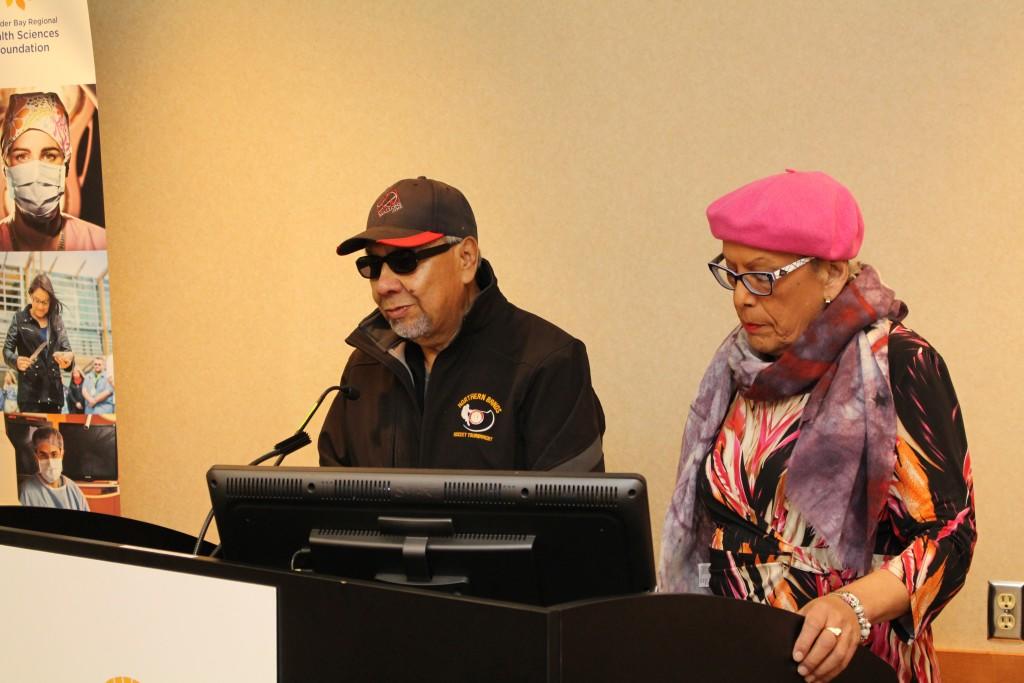New Kidney Treatment Video Aims to Support Aboriginal Patients in Decision Making
by Sara Chow
 Harvey Kakegamic and Mona Hardy are two patients who volunteered to share their stories in the video, each explaining the changes that many patients experience.
Harvey Kakegamic and Mona Hardy are two patients who volunteered to share their stories in the video, each explaining the changes that many patients experience. “Making a decision about treatment for chronic kidney disease is really about making a decision about the rest of your life,” explains Mary Wrigley, Manager of the Northwest Regional Renal Program at Thunder Bay Regional Health Sciences Centre (TBRHSC). “Patients have options for treatment, and their choice is important because it needs to fit their lives, as well as their families’.”
To celebrate World Kidney Day, TBRHSC launched a new locally produced video, made in partnership with Amgen, to support decision making for Aboriginal patients who have chronic kidney disease. “The video will be a useful tool for patients because it shapes the experience of living with kidney disease using storytelling, and is available in Aboriginal languages,” says Wrigley.
Treatment choices for kidney disease fall into four primary categories: conservative treatment (let the disease run its course), kidney transplant, hemodialysis and peritoneal dialysis. In addition to a treatment that will be required for the remainder of a patient’s life, there are many lifestyle changes, including strict dietary restrictions, living situations, family relationship changes, etc.
Two patients volunteered to share their stories in the video, each explaining the changes that many patients experience. Mona Hardy, a hemodialysis patient at TBRHSC since 2004, joined the project to help others. “I think it’s very important, not just for Aboriginal people, but for everyone to know that dialysis changes your life. It’s not a small thing. Treatment is a big decision. Lots of people experience different emotions when they are diagnosed and it can be tough, but they need to choose to live.”
Harvey Kakegamic, a peritoneal dialysis patient from Sandy Lake First Nation, also allowed filmmakers to visit him at home and show them his typical day and discuss his treatment decision. “When I found out about this kidney problem, I was in the dark, not knowing what was going to happen to me. I thought it was the end of my life. But, the program really lifted me up. We can still enjoy life, even though we this treatment as part of our lifestyle. It has helped me for the last 2.5 years. I really want to encourage my First Nation people to take care of their health,” says Kakegamic.
Currently, there are approximately 850 patients with the Northwest Regional Renal Program who require regular treatment. With one in every ten Canadians expected to develop chronic kidney disease in their lifetime, a prevalence that is higher among Aboriginal populations, the number of patients is expected to increase. Patient-centred tools that help increase education and awareness about kidney disease and its treatment are vital to providing appropriate and high quality care.
To further increase awareness about kidney health, TBRHSC also partnered with The Kidney Foundation of Canada to host an education booth in the hospital.
To learn more about living with kidney disease and treatment choices, view the full video at www.tbrhsc.net/lifewithkidneydisease.
For more information, please contact:
Sara Chow
Health Promotion & Communications Planner
Prevention & Screening Services
Thunder Bay Regional Health Sciences Centre
(807) 684-6716
chows@tbh.net